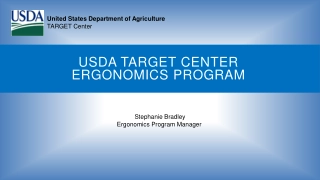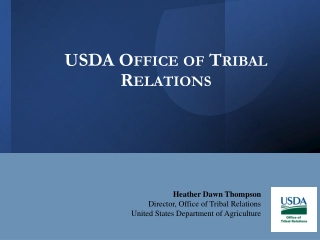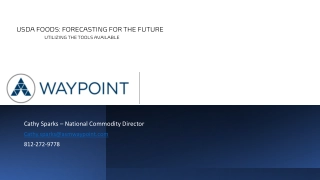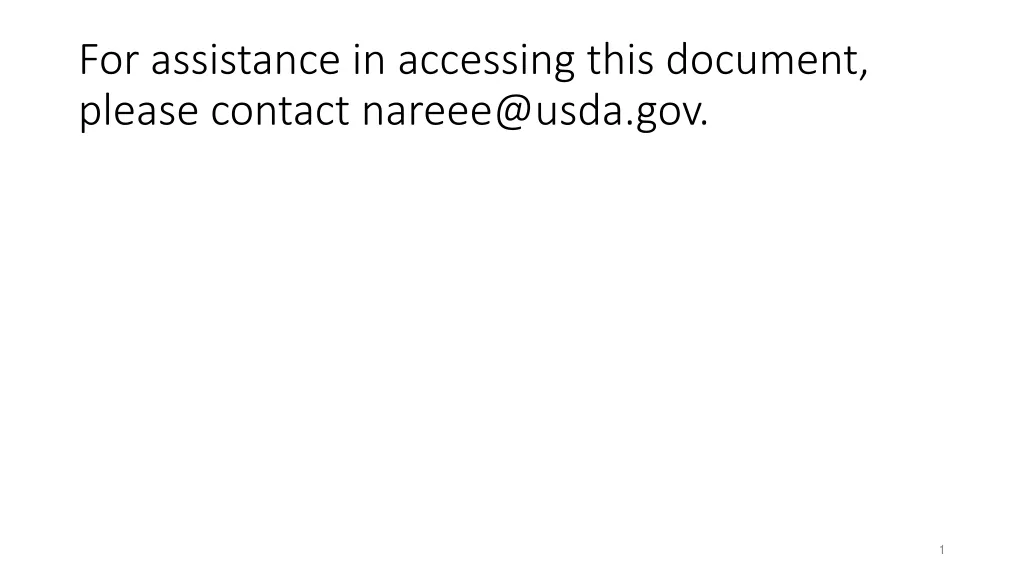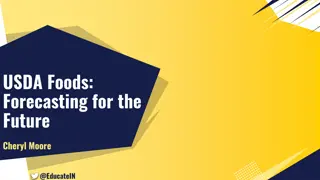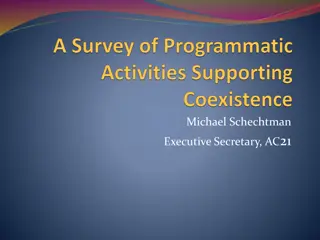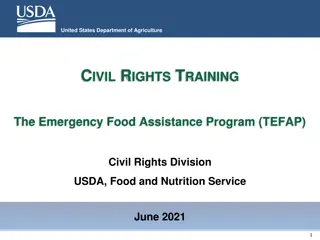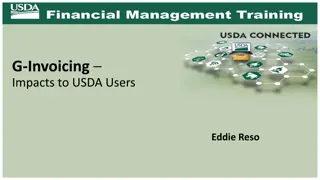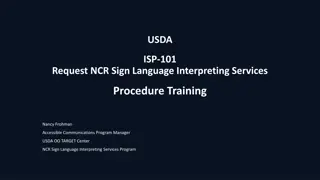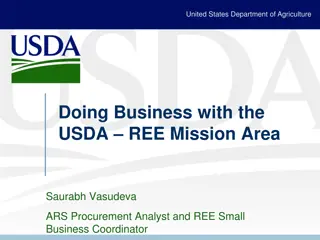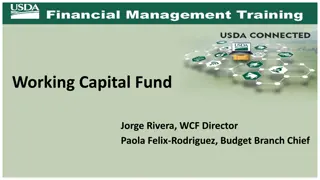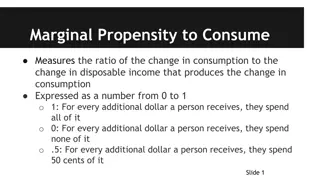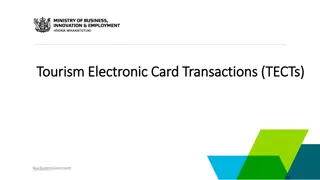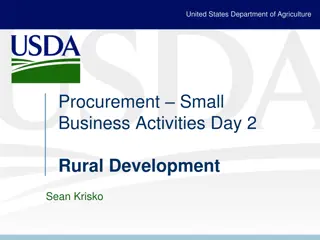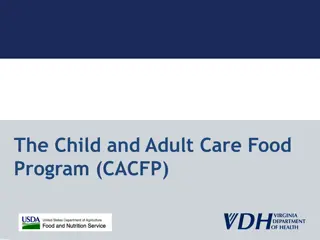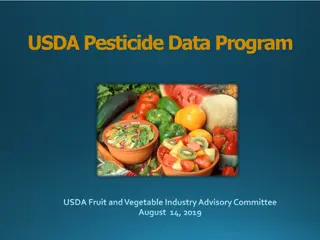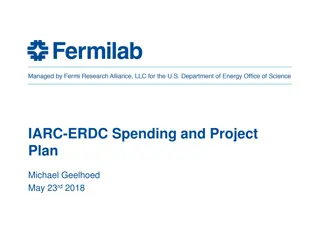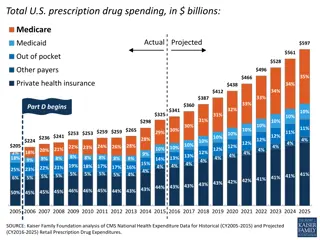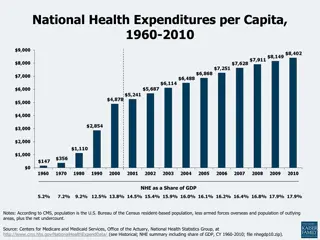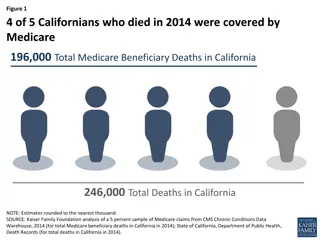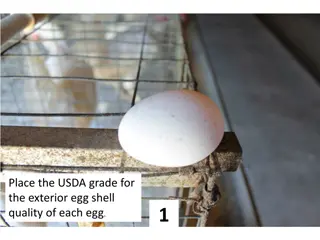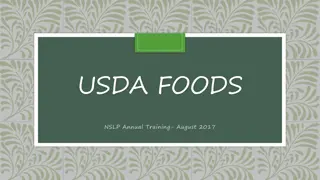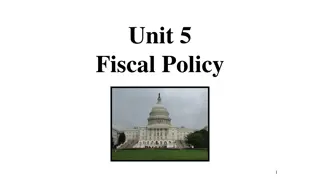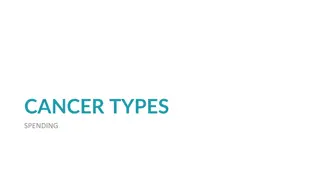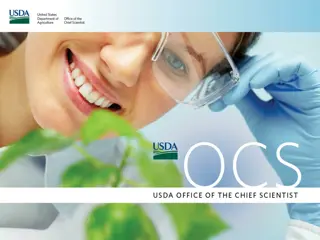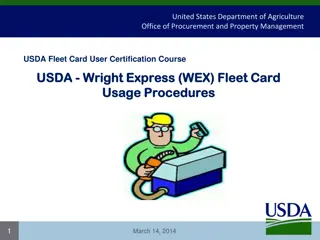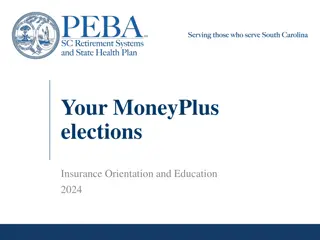USDA TARGET CENTER ERGONOMICS PROGRAM
Workplace ergonomics and the USDA TARGET Center's program for improving workplace health and productivity. Understand risk factors, prevention principles, and resources available for ergonomic support.
0 views • 37 slides
USDA Tribal Relations and Federal Policy in Native Agriculture
Explore the role of the USDA Office of Tribal Relations and the USDA Tribal Advisory Committee in addressing barriers and federal policies impacting tribal agriculture. Learn about tribal eligibility, statutory requirements, and the historical eras of federal Indian policy affecting Native American
0 views • 36 slides
Streamlined Forecasting for Future USDA Foods Utilization
Cathy Sparks, National Commodity Director, discusses the importance of communication in the forecasting process for USDA foods. Tools like the ProcessorLink calculator and K12 On Target planner help processors and distributors estimate quantities needed for production. Commodity Planning Made Easy s
0 views • 9 slides
USDA DEIA Strategic Plan Overview
The United States Department of Agriculture (USDA) is prioritizing Diversity, Equity, Inclusion, and Accessibility (DEIA) through various initiatives and actions. The agency is focused on promoting a diverse workforce, ensuring equitable access to programs, and fostering an inclusive workplace envir
1 views • 12 slides
USDA Accessible Communications Program Overview
Advancing access and equity for individuals with disabilities is a key focus of the USDA Accessible Communications Program. Through initiatives like the National Disability Employment Awareness Month events and implementing the Rehabilitation Act, the program aims to promote accessible communication
5 views • 28 slides
Building a Trauma-Informed Workplace for Equitable Employment: USDA Symposium 2023
Explore the imperative of creating trauma-informed workplaces at the National Disability Employment Awareness Month Symposium hosted by USDA Target Center. The event sheds light on the prevalence of workplace trauma, its impact on mental health, and steps to advance access and equity. Gain insights
2 views • 36 slides
Effective USDA Foods Procurement and Forecasting Strategies
Managing USDA Foods procurement involves analyzing historical data, estimating future trends, and streamlining menu planning to save time and reduce costs. Standardized recipes and inventory management are crucial for efficient operations. Understanding the location and value of USDA Foods, along wi
8 views • 11 slides
2024 Health Benefits Enrollment Information for Commonwealth of Virginia
The 2024 Open Enrollment for Health Benefits and Flexible Spending Accounts in the Commonwealth of Virginia is scheduled from May 1 to May 15. This period allows individuals to make decisions regarding health plans, flexible spending accounts, and other benefit options. Changes made during this time
0 views • 39 slides
Ongoing USDA Programs and Biotechnology Research Overview
This overview delves into ongoing USDA programs such as the Biotechnology Risk Assessment Grants (BRAG) Program, which supports biotechnology research. The program covers risk assessment, management, pollen flow research, gene transfer control methods, and more. Additionally, voluntary market facili
0 views • 16 slides
USDA Civil Rights Training for TEFAP Program
The USDA Civil Rights Training emphasizes the importance of training for state agencies, subrecipient agencies, frontline staff, and volunteers involved in the Emergency Food Assistance Program (TEFAP). It covers various aspects of Civil Rights compliance, including public notification, complaint pr
0 views • 48 slides
New Employee Benefits Overview for USDA APHIS and AMS Employees
Get insights into the array of benefits available for eligible employees of USDA APHIS and AMS, including details on life insurance, health insurance, dental and vision insurance, flexible spending accounts, retirement plans, and more. Understand eligibility criteria based on appointment types and w
0 views • 24 slides
Understanding G-Invoicing Implementation at USDA
G-Invoicing is an online portal facilitating electronic information exchange for interagency agreements among Federal agencies. The system streamlines invoicing processes, standardizes transactions, and enhances communication for reimbursable activities. The implementation at USDA involves mandatory
0 views • 26 slides
USDA In-Person Sign Language Interpreting Services Training Overview
This training session provides essential information for USDA employees on requesting in-person and virtual sign language interpreting services in the National Capital Region. It covers policy reviews, training completion, requesting procedures, and resources available through the USDA NCR Sign Lang
0 views • 23 slides
USDA REE Mission Area Overview and Procurement Guidelines
The United States Department of Agriculture's Research, Education, and Economics (REE) mission area comprises four agencies dedicated to enhancing the food and fiber system. The REE agencies facilitate procurements for various services and equipment, striving to achieve small business participation
1 views • 11 slides
Importance of Moderation in Spending and Consumption
The content emphasizes the significance of moderation in spending, as highlighted by a Noble Hadith, encouraging controlled spending and rationalized consumption. It warns against extravagance and advocates for balanced use of resources. By practicing moderation in food, drink, and clothing, individ
2 views • 19 slides
Understanding the Working Capital Fund: Governance, Services, and Structure
The Working Capital Fund (WCF), established in 1944, is a fund without fiscal year limitation that supports centrally-managed Activity Centers providing various services such as Information Technology, Financial Management, and Administrative Services to USDA and Non-USDA organizations. The WCF empl
0 views • 11 slides
Understanding Marginal Propensity to Consume and Save
Marginal Propensity to Consume (MPC) and Marginal Propensity to Save (MPS) measure the ratios of change in consumption and saving to change in disposable income respectively. The relationship between MPC and MPS shows that they equal 1 when combined, with the remainder being saved. The multiplier ef
7 views • 5 slides
Behavioral Life-Cycle of Saving and Spending in Finance
Explore the behavioral aspects of saving and spending in the life-cycle theory of finance. Learn how individuals reconcile conflicts between saving and spending desires through mental accounting, self-control, and framing. Discover the various sources and uses of spending, including luxury items and
0 views • 18 slides
Understanding USDA Watershed Programs for Local Communities
USDA Watershed Programs offer assistance in addressing natural resource issues such as flood control, repairing flood damages, and rehabilitating flood control dams. The three major components - Emergency Watershed Program (EWP), Watershed Protection and Flood Control Program (WPFO), and Watershed R
0 views • 15 slides
Updates on Tourism Electronic Card Transactions (TECTs) and Spending Trends
Changes to the Tourism Electronic Card Transactions (TECTs) have been made, including the reinstatement of the international category and implementation adjustments for domestic spend. The Australian market has been split out within the international category. Caution is advised when interpreting TE
0 views • 10 slides
USDA Rural Development Contracting Overview
USDA Rural Development's procurement activities focus on supporting small businesses through various contracting divisions and contract types, with a significant achievement in small business contracting in FY22. The agency's top spending categories include professional, scientific, and technical se
0 views • 8 slides
Overview of Child and Adult Care Food Program (CACFP)
The Child and Adult Care Food Program (CACFP) is a federally funded program aimed at subsidizing eligible institutions to provide nutritious meals to children and adults, promoting lifelong healthy eating and physical activity habits. Administered by the USDA and implemented by various programs, CAC
0 views • 21 slides
USDA Pesticide Data Program Overview
The USDA Pesticide Data Program (PDP) provides high-quality pesticide residue data for US foods to support regulatory decision-making and ensure food safety. Through cooperative agreements with participating states, the program conducts sampling of various commodities, including fresh fruits and veg
0 views • 17 slides
Overview of USDA Food Distribution Program
The USDA Food Distribution Program aims to support American agricultural markets and provide nutritious food to schools. With over 17 million entitlements distributed annually, the program ensures that USDA foods are domestic and meet nutritional goals. Service fees cover various administrative cost
0 views • 15 slides
Managing Finances in the United States: Creating a Spending Plan
Explore the importance of creating a spending plan to cover basic living needs, care for family, purchase desired items, and manage financial obligations or debts. Learn about different types of expenses, frequency of occurrence, and how to start creating a personalized spending plan based on your i
0 views • 14 slides
Financial Overview of IARC-ERDC Spending and Project Plan by Michael Geelhoed
Delve into the detailed breakdown of spending, challenges, progress, and future steps outlined in the IARC-ERDC Spending and Project Plan presented by Michael Geelhoed. The plan includes cost allocations for various components like RF Coupler, SRF Gun, Cryostat, and more, as well as projections and
0 views • 5 slides
Overview of U.S. Prescription Drug Spending and Medicare Part D
U.S. prescription drug spending data from 2005 to 2025 shows trends in various payer contributions, with predictions for future years. Medicare Part D's drug spending is broken down, revealing top drugs and rebate percentages. The total Medicare spending in 2015 and average annual growth in Medicare
0 views • 10 slides
Overview of U.S. Health Care Expenditure Trends
Analysis of U.S. health care expenditure trends from 1960 to 2010, including per capita spending, share of GDP, concentration of spending in different income brackets, growth rates compared to GDP, and impact of cost on access to care. Data reveals the increasing financial burden on individuals, dis
0 views • 6 slides
Integrating Spending Reviews into the Budget Cycle: Best Practices and Recommendations
To integrate spending reviews effectively into the budget cycle, align the process with the budget calendar, ensure consistency with medium-term frameworks, and incorporate outcomes into budget decisions. Countries like Australia, the UK, Ukraine, Italy, and Slovakia have institutionalized spending
0 views • 11 slides
Medicare Trends in End-of-Life Care for Californians
Californians who died in 2014 were analyzed in terms of Medicare coverage, spending at the end of life, and hospice care utilization. The data shows a decrease in the share of total Medicare spending, variations in spending with age, and an increase in hospice use and spending over the years. Furthe
0 views • 6 slides
Identifying USDA Grade for Exterior Egg Shell Quality
This content presents images of individual eggs and asks users to place the USDA grade for each egg's exterior shell quality. The images provide a visual assessment challenge for viewers to gauge shell quality based on USDA standards.
0 views • 15 slides
USDA Foods Program Overview: School Lunch Program Details
Schools and agencies participating in the National School Lunch Program can receive USDA Foods, with entitlement rates set annually by the USDA. The program includes direct and processed options, along with specific delivery schedules and administrative fees. Ordering takes place once a year, with o
0 views • 19 slides
Understanding Government Tools for Economic Stability
The government uses fiscal and monetary policies to stabilize the economy. Fiscal policy involves Congress's actions through government spending or taxation changes, while monetary policy is driven by the Federal Reserve Bank. Discretionary fiscal policy involves new bills designed to adjust aggrega
0 views • 36 slides
Comprehensive Overview of Medical Spending Accounts for 2024
Explore the details of Medical Spending Accounts (MSA) and Limited-use Medical Spending Accounts for the year 2024, including eligibility, contribution limits, eligible expenses, carryover options, deadlines, and administration fees. Learn how these accounts can help you manage your healthcare expen
0 views • 9 slides
Cancer Types Spending in Europe
Learn about the spending on various types of cancer in Europe including breast cancer, colorectal cancer, prostate cancer, lung cancer, ovary cancer, and pancreatic cancer. The information is based on the Comparator Report on Cancer in Europe 2019, which covers disease burden, costs, and access to m
1 views • 7 slides
USDA Office of the Chief Scientist Overview
The USDA Office of the Chief Scientist (OCS) plays a crucial role in facilitating scientific coordination and collaboration across USDA agencies. It comprises a structured organizational setup with key positions dedicated to scientific integrity, communication, and coordination. The Acting Chief Sci
0 views • 12 slides
Sustainable Health Care Cost Growth Trends in Oregon, 2020-2021
The Sustainable Health Care Cost Growth Target Program in Oregon aims to regulate the annual per person growth rate of total health care spending. Reports show a 3.5% increase in total health care expenditures per person in 2020-2021. The link between Medicaid enrollment and spending is highlighted,
0 views • 31 slides
USDA Fleet Card Program Usage Procedures
The United States Department of Agriculture (USDA) outlines the procedures and guidelines for using the USDA-authorized Wright Express (WEX) Fleet Card for fuel, maintenance, and repair services for USDA-owned and commercially-leased vehicles. The program covers specific authorized uses such as fuel
0 views • 12 slides
Flexible Spending Account Options for 2024
Explore the various Flexible Spending Account options available for 2024, including Medical Spending Account, Limited-use Medical Spending Account, Dependent Care Spending Account, and Pretax Group Insurance Premium feature. Learn about contribution limits, reimbursement deadlines, and enrollment re
0 views • 9 slides
USDA Office of Technology Transfer Patent Program Overview
USDA Office of Technology Transfer's Patent Program provides professional services for creating, managing, and convening Utility Patent Review Committees, preparing and prosecuting U.S. patent applications, advising on patent policies, and facilitating foreign filings. The process for protecting USD
0 views • 24 slides
